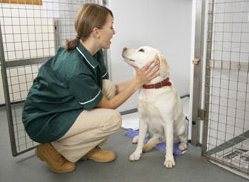
April is National Heartworm Awareness Month. Dogs are not the only pets that can get Heartworm disease, but they’re the natural hosts for these deadly parasites – and the short story is, every dog’s best line of defense is a year-round heartworm prevention program.
What are heartworms?
Heartworms are a parasites that can grow to be a foot long. They live for up to 5 years, during which time they can produce millions of offspring called microfilariae. Adult heartworms live in the heart and adjacent large blood vessels, and one infected dog can have as many as 300 worms when diagnosed; the microfilariae live mainly in the small blood vessels of the body.
How does a dog get infected?
When a mosquito bites an infected dog, it sucks up the microfilariae, which then live in the mosquito in order to mature into infective larvae. At this point, they make their way to the mosquito’s mouthparts where they can be transmitted when the mosquito bites another dog. They grow to maturity and can begin producing new offspring within 6 to 7 months.
Heartworms must have the mosquito as an intermediate host, which means that a dog cannot catch heartworms simply by interacting with an infected dog.
What are the signs of heartworm disease?
It can take several years before a dog starts to show signs of illness. While the signs vary depending on how long the dog has been infected, how many worms are present, and so on, the typical signs of adult worms include:
- Soft, dry cough
- Shortness of breath
- Weakness and loss of stamina
- Nervousness
- Fainting or disorientation, especially after exercise
Since the microfilariae can cause lung and liver damage, dogs infected with microfilariae may cough, look jaundiced, and be weak.
How is heartworm disease diagnosed and treated?
There are several simple blood tests for heartworm disease. A positive test result means further tests will be needed to determine whether the dog is well enough to undergo treatment.
Treatment is a long road, and the dog must be treated with different drugs to kill the adult heartworms as well as the microfilariae.
After the injections for adult heartworms, the dog must be kept very quiet. The adult heartworms die within a few days, and they break up and leave the heart, traveling to the lungs to be reabsorbed by the body. But the fragments of dead heartworms can cause serious complications and even death, so it is absolutely essential that the dog be kept quiet and avoid exercise for a full month following treatment.
About a month after the treatment for heartworms is complete, the dog will stay in the hospital for a day or two for the treatment to kill the microfilariae.
How can I protect my dog from heartworm disease?
All dogs should have annual heartworm tests and be on a preventative program. There are plenty of safe and effective options available including oral and topical medications. They need to be given exactly as directed because missing even one dose can leave your dog unprotected.
As a bonus, some heartworm preventatives also protect against either internal parasites (such as tapeworms) or external parasites (such as fleas). Talk to your veterinarian about the best option for your dog.
The American Heartworm Society recommends that all dogs be on heartworm preventatives year round, even in cold areas. Even though mosquitoes are more common in the warmer months, many can survive indoors all year.
